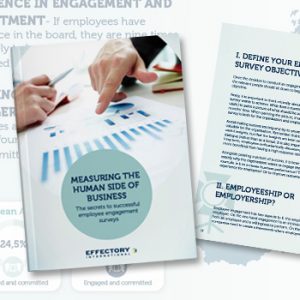Underlying best practices for employee engagement surveys are five critical features. Globally 28% of employees are engaged in their work. Within Europe, the engagement figure lags slightly behind at 27% and between countries and regions there is much variation in engagement levels. Some regions such as the Nordics reach levels of 30%, whilst others such as the UK & Ireland are struggling to reach 20%.
5 best practices for employee engagement surveys

Employee engagement isn’t static
It is important to remember that engagement levels fluctuate, and that employee engagement isn’t static. Individual levels change over time, with employees’ personal engagement varying over the course of a year. Despite the fluctuations, we seldom see engagement levels above 40% in organisations.
Why engagement surveys should focus on teams
Over the last few years much attention has been given to employees’ engagement, and there have been some fantastic initiatives launched by organisations. Having said this, the latest figures clearly indicate that if organisations are to reap the full benefits of engaged employees, there’s still much to be done.
Step #1: how to conduct an employee engagement survey
Human side of business engagement e-book
Discover the secrets to successful employee engagement surveys.
DownloadThe benefits of engagement and measuring it
From experience we’ve learnt that employee and customer engagement are good predictors of organisational performance. Engaged employees are passionate about their work, and passionate employees take better care of their customers. The direct result is that customers are likely to increase their spending with the company. In other words, passionate and engaged employees increase a company’s value.
There is little doubt that hard figures and traditional KPIs still remain important, but in today’s fast paced world organisations also need to know what is happening with employees and their engagement in work. Without it, organisations are operating in the dark.
If companies really care about the financials and numbers, they should invest in measuring employee engagement and taking actions to increase it. The benefits of measuring engagement is that engagement surveys when applying best practices, shed light on the human side of business. They allow organisations to get insight into how their employees are doing and further, they allow managers to see what aspects are barriers to high performance and engagement.
5 employee surveys best practices
Underlying best practices for employee engagement surveys are five features:
1. Buy in from the top
Employee surveys best practices start with commitment from the top. If senior management and decision makers don’t take surveys seriously and show real commitment, employees won’t commit to the process either.
2. Short, attractive questionnaires
Long gone are the days of questionnaires that are 120 questions. Making it easier for the employee to fill in the questionnaire aids response rate and sharpening what you want to measure creates relevant reports.
3. Action based
If you can’t act upon the question, don’t ask it. The cardinal sin of surveys is not doing anything with them. Setting up the survey for action is therefore not only practical, but also makes life easier later in the project phase.
4. Reporting at the team level
Most of employees work experience is on a team level and that is where the action happens. Reporting what happens at the team level and acting upon it delivers the best results. As a rule of thumb for employee surveys best practices, we recommend doing this alongside three organisational wide themes.
5. Frequency
The last best practice for employee engagement surveys is don’t wait 2 years between surveys. An awful lot can happen to an employee in two years, and the impact of planned actions is extremely hard to measure after so long. If you want to address engagement, keep surveys short and measure regularly.
Book a free demo. See our solutions in action.
Effectory is Europe's Leading provider of Employee Listening Solutions. Schedule a product demo and discover how to enhance your employees' engagement.
Demo request
